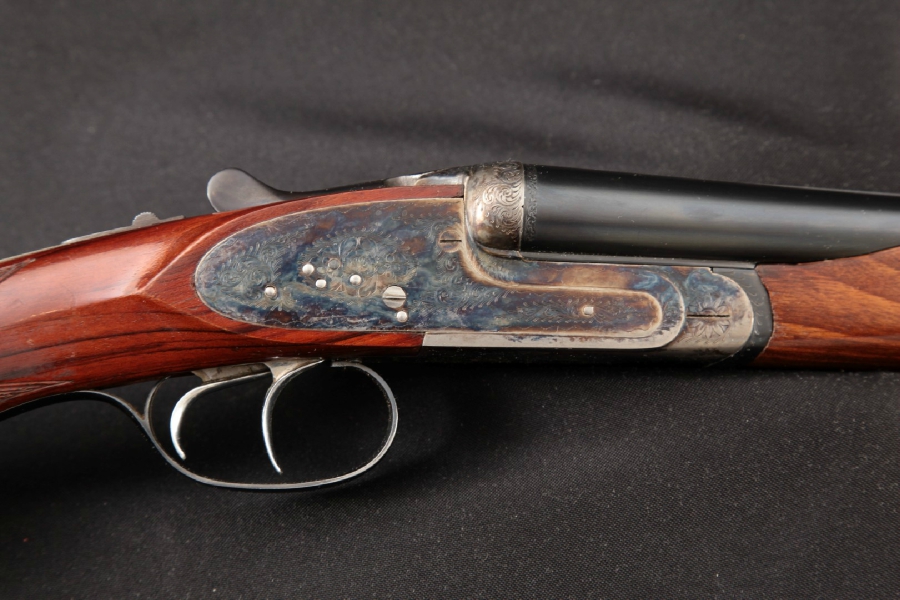Victor Sarasqueta Shotgun Serial Numbers
Folks,I've still not learned my lesson - I'm still perusing Gun Broker. I was doing so and came across a Victor Sarasqueta (Stoeger Sterlingworth's) 20 Gauge Sidelock – priced to move at $635. The gun frankly looked too good:These guns were generally well used, and showed it. The extremely nice condition of this one made me think there was a problem somewhere.But I’m a sucker for VS guns, English stocked sidelocks, and light 20 gauge guns, all of which came together in this gun.

I didn’t see any outward signs of damage, or indication of problems in any of the pictures posted by the seller (who had A grade feedback from prior sales). And the unusually long fore end intrigued me:So I took the plunge, bid, and got it at the starting bid. When it came in it looked even better in person than it did in photos. And I found the problem – a broken right firing pin. Easily solved, and I’m a happy camper.Here are the barrel flats and the watertable:Here are the left side plate and lock works:Note the unusual location of the screw that traverses the stock and secures the left and right locks together; It goes through the bridle.And here are the right side plate and lock works:I’m quite happy with the gun, broken firing pin notwithstanding. Hi Gents,David may well be right – the length of the fore end is consistent with a beavertail fore end.

So we may have a fairly standard Sterlingworth’s (i.e. A gun originally made with an American style stock) that was customized by/for a prior owner.OTOH, is the stock is a conversion it’s a very odd conversion. Removing the pistol grip and reshaping the butt and fore end remove a lot of the original checkering.
Usually, in such conversions, the original checkering is extended onto the refinished raw wood exposed by the conversion. The fore end is also usually shortened to the splinter style of fore end length. All of this causes problems with the metal work (trigger guard tang, fore end iron). The trigger guard tang has to be reshaped (and should be shortened – as should the fore end iron) and the butt stock inletted to accept the trigger guard tang (same for fore end and fore end iron).Sometimes a decision is made to remove all the original checkering and re-checker with a checkering pattern more consistent with an English style stock. If the re-stocker goes this route he buys some additional problems with the fore end escutcheons (which will be proud due to the removal of the original checkering), which must be solved.With all of that as prolog, this may not be a conversion stock. There are no signs either part of the stock ever had checkering, so if both were originally checkered the removal of that checkering was complete.
Neither of the escutcheons are proud, nor is the fore end iron. While all of this suggests the stock is original and unaltered, none of it proves this is the case. It could be that, if the stock was altered, it was done by someone with either a lot of experience or a very great deal of good luck. Who also hated checkering.Bottom line for me, is I cannot tell is this is a custom gun (‘bespoke’ for those who prefer the English term), or a customized rack grade gun. As a third alternative, I have seen a few Stoeger Sterlingworth’s that were (IMO) originally stocked in the English style, and this may be a one such (or a one-off assembled by VS and included in the Stoeger contract by the maker’s whim or the buyers request).Finally, I think we are not likely to ever have a definitive answer as to whether this gun has an original and unaltered stock, or a stock customized after delivery.
I’m also inclined to place little value on the question, and the answer. I like the gun, regardless of its provenanceKyrieModerator - SpanishShotgunForum on Yahoo Groups( ). You are going to do one of several things:1. Send the gun to a gunsmith and have him fabricate the parts2.
Buy a like model parts gun and cannibalize the parts3. Buy a working gun and use your gun as a parts gun.Sarasquetas are not made anymore and most of the parts were hand fitted for each particular gun, so even if you get parts, they are going to need to be fitted by a smith.Firing pins and springs are generally available, but everything else is a tough find.KyrieModerator - SpanishShotgunForum on Yahoo Groups( ). Hi Mike,Thank you, sirI'd already seen that one - the seller is the same shop from which I bought my 20 gauge, and he put both guns up at just about the same time. I wasn't too interested in the 12 gauge because it's a 12 gauge, American stocked, and has the wear (and then some) I'd expect to see on a Stoeger Sterlingworth's (note the near compete absence of any remaining case color).The beavertail fore end on the 12 gauge is about the same length as the splinter on the 20 gauge. OTOH, by comparing the pictures of the 12 and 20 we can see that if the 20 gauge fore end was reduecd to splinter from beavertail just how aggressively the fellow that did the work would have had to have been in removing the checkering. Also note that the butt stock of the 12 gauge has drop points which the 20 gauge butt stock does not - something else that would have had to have been removed if the 20 gauge butt stock is an alteration from the common pattern seen in the 12 gauge.It's an interesting puzzle, with evidence for either point of view on whether the stock on the 20 is original or altered.KyrieModerator - SpanishShotgunForum on Yahoo Groups( ).
Hi all,I was smitten by gorgeous wood and now own a fine VSS 12ga. I'm happy to find this site and thread about my 'mystery' gun. I made a fool of myself on another thread recently as I believed to have false sideplates. I'm elated to be the 'accidental' owner of a true sidelock. Again, smitten by the intriguing wood, slender wrist and double trigger.
With pleasure must come pain-two buggered screw heads. One on a plate and the other on the underside of the watertable. Anybody have a couple to spare? Am I correct in presuming you mean the four digit numbers on the lock plates and barrel flats? If so these aren't serial numbers - they are bench assembly numbers.Spanish gun makers will sometimes use an assembly number, rather than a serial number, to associate the parts being fitted together into a specific firearm. This is a common practice in Spanish handguns, but is only rarely seen in shotguns (Llama was infamous for the practice, and generally used Roman numerals). In essence, a gun isn't given a serial number until it is a complete firearm so a serial number isn't available during the assembly process - hence a bench assembly number.An assembly number is useful only when the assembler is working on more than one gun at a time, and that may be why we see assembly numbers frequently in handguns, but only seldom in shotguns.This kind of thing is one of the reasons I enjoy Spanish Steel so much.
There are just so many off-the-wall (to American eyes) things the Spanish do as a matter of practice. It's possible to find an Astra Model 1921 (AKA Astra Model 400) with commercial proof and military property markings, or with commercial proof only, or with military property marking only, or with no proof or property markings at all! Did anyone notice that the serial numbers don't match? The side plates & barrel flats are stamped with four digits that should match the last four of the reciever.
Victor Sarasqueta Eibar
Fore end iron and wood should also have the same four digits. Metha metha hai mere muhammad ka naam by junaid jamshed mp3 download. If you remove the trigger guard those same digits would be stamped on the stock.
Did someone put together one gun out of two? Not that it matters, if you shoot it well and like the gun that's all that counts!KyrieModerator - SpanishShotgunForum on Yahoo Groups( ). Kyrie, When I mentioned the serial number issue, I speak from my own observations of my guns. I have VS made and Stoeger imported Zephyr Sterlingworths in 12, 20 and 28 gauges. All major components are stamped with the last four digits of the serial number. The forend wood has the complete serial number stamped on it. Perhaps because your gun is unusual, with the stock and forend, It may have been returned to the factory for refitting and new parts installed.I'm not disputing your experience or observations – I have a VS marked just as you describe.

I’m only pointing out not all VS guns are marked in that same way.The 20 gauge VS Sterlingworth's pictured in this thread has the full serial number on all the major parts (receiver, barrels, and fore stock) and all of these serial numbers match the serial number visible in the photo of the receiver's water table. The barrel serial number is not on the water table; it's on the base of the fore end hanger.In addition to the serial number, the barrels and locks also have a four digit assembly number, not related to the serial number, stamped on the locks and barrels and visible in the photographs.The 20 gauge VS Sterlingworth's is not unique in this treatment of having both serial numbers on the major components and assembly numbers on the barrels/ locks, and there are many other Spanish sidelock shotguns (not just VS guns) where this same numbering technique is used.
Other examples of locks with assembly numbers are pictured in the thread on Borchers marked sidelocks.In that same vein, here are photos of another VS Sterlingworth’s – this time a 16 gauge – that shows the same pattern of serial number and assembly number.The underlying datum to all of this is Spanish gun makers are not cursed with an obsessive need for consistency. They do things as circumstance warrant, or whim takes them.As an aside, I think it’s interesting that VS would put the last four digits of the serial number on any of the locks on its guns, Most other makers usually didn’t - and don’t. As an exercise, page back through the threads where folks have shared pictures of the lock works of their guns, and count how many have locks have anything even remotely resembling a serial number.